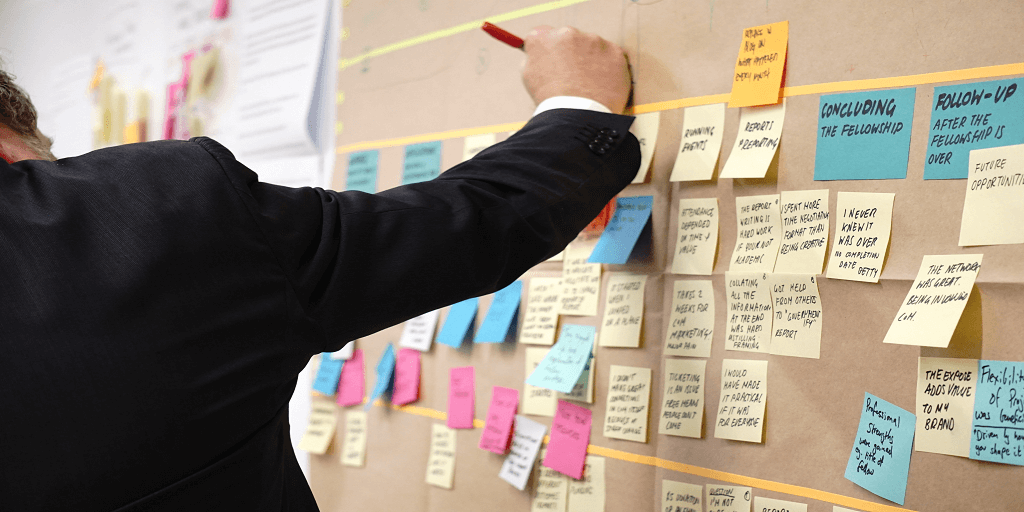Projects, no matter their scope, duration or size, need a carefully built project management plan.
This is true regardless of the project management methodology used to manage the project.
Be it traditional (waterfall), Agile or Hybrid project management method, all projects need well thought of and executed the project plan.
Projects involve people, resources, and tasks which are difficult to understand and manage.
Even the smallest and the simplest of projects need a good project plan!
Without a proper project management plan, there will be a high probability of mistakes, project failures, and missed opportunities.
The historical project success rates are low. To improve the project’s success rate, you need to start with proper planning.
To make this point as clear as possible, the first and the most crucial step when starting a project is creating a comprehensive project management plan.
We suggest starting with a project management template, instead of creating a plan from scratch.
This will save you time and reduces the possibility of mistakes or leaving things out.
Having chosen a template, we will outline some of the key components of creating a project management plan that will help you to ensure your project’s success.
Project Management Plan Summary
Your project management plan is not just meant for your colleagues, upper management, shareholders, or investors!
The primary function of the plan is to benefit most and foremost you and your team.
As such, you should create a brief guide in the opening pages of the document to make the highlights clear to everyone.
The summary tells the reader what the project aims to solve or find answers to.
The summary should give an overview of the goals to be achieved and deliverables and their timing.
But the summary should not be very long.
Keep it concise, break it up into sections, and consider adding visual elements like icons and graphs to convey milestones that need to be achieved.
There are many ways to present your summary but the primary aim is to inform your reader and yourself the high-level details of the project.
Add here, when the project starts, ends, the resources it needs, the goals the project has, how do you define success, and if there are any challenges you do foresee during the project’s lifecycle.
Add a risk planning section for each challenge you do identify.
Full Project Scope
Whereas the summary gives readers a brief understanding of what the project entails, the project scope outlines to your stakeholders the finer details involved in the project.
This includes the processes to be incorporated into the project, deliverables, project goals, major deadlines, and budgets.
Your project scope will also feature product details, website management or updates, marketing tactics, and the project management software to be used.
Another crucial aspect of the project scope is what the project cannot cover—you need your stakeholders to be clear about what will be delivered at the end of the project.
The project scope is where you can inform your stakeholders if something is beyond the range of the budget, or cannot be completed within the time frame.
Timeline
Projects cannot go on indefinitely, which is why a timeline needs to be included in your project management plan
Use a Gantt chart to incorporate a primary timeline for the duration of the project, like in the below example.
These simple bar graphs make it easier to read and absorb information—a few of the many benefits of Gantt charts.
You can also use Gantt charts to assign tasks to teams or individuals, so everyone involved in the project knows who is responsible for what task.
Depending on the scope of your project, your project management plan may require more than one timeline.
For larger projects with a broad scope, you could have one high-level timeline and several timelines for further team responsibilities.
The purpose of timelines is for everyone involved to know when tasks have to be completed to ensure that the project doesn’t get derailed and you don’t lose time.
Budget and Resources
Your project scope will already have outlined budgetary requirements for the project. But you should keep a section of your project management plan to break down the budget further.
In this section, you should highlight how the budget will be distributed across the various avenues of the project.
What amount will be spent on personnel, equipment, materials, and conveyance? Do personnel need training or other resources? That should be included in the document.
You also need to write about the human resources required for the project. How many people will be involved and in what capacity? Who will they be reporting to?
Consider creating an organizational chart to clarify who is involved in the project and what they will be doing, as in the below example.
The chart will inform stakeholders of who they need to speak to for any project-related matters. But it will also act as an impetus for the project teams to put in their best as they will know they aren’t being treated as anonymous cogs in a wheel but as valued project members.
Risk Management Plan
No project can be completed without a single hiccup. There will always be some issues that crop up, albeit unwittingly. These problems need to be accounted for before the project even gets underway.
Start by identifying what could go wrong—if the project is related to factory work, some of the issues you could face could include machinery malfunction, personnel injury, or parts not arriving on time.
Once you have identified the potential problems, map out the contingencies and solutions you can implement. Such as alternative machinery to be used, perhaps some CNC machining or similar, backup personnel with comparable skills, and secondary manufacturers who you can contact for parts.
Risk management may seem like an exercise in futility because not everything you imagine going wrong will go wrong. But the old adage—better safe than sorry—is critical to ensuring a successful project.
Communication Plan
For the majority of the time, the project management plan will be handled by the project manager.
But what about everyone else involved in the project? How will they receive updates or changes, that could affect their working schedule or tasks? How will you inform stakeholders of how well the project is going?
Your project management plan needs to include methods of communication. Create a project status report that you will share at particular dates and times—such as a week before a deadline, every month, quarterly, or annually.
Below is an example of a project status report that you can use as inspiration.
Regular updates will ensure that everyone is on the same page, that there is no duplication of tasks, and that any potential issues are flagged at the earliest.
Conclusion
Projects take time and energy to complete. There are a number of factors involved, which affect the project’s success.
The number one factor in the success of any project is the people who work and manage the project.
The second one is to have a great plan.
Keeping everyone on the same page and up to date has to be a priority for a project manager.
As project management plan gets updated and revised, make sure everyone has real-time access to it.
The best way to do that is for everyone to have access to the project plan as a secure and online document.
Begin the document with a concise summary of what the project entails, then outline more detail in the project scope.
Always include a timeline, preferably using a Gantt chart, and detail the budgets and resources required for the overall project.
Projects can be easily derailed so identify risk factors in advance, and plan out communication methods to keep everyone informed.
With these key components in place in your project management plan, you can begin working on what will eventually be a successful project.
 Ronita Mohan is a content marketer at Venngage, the online infographic and design platform. Ronita is interested in a variety of topics related to digital marketing, visual content, and online engagement, which she enjoys researching and writing about. Twitter: @Venngage
Ronita Mohan is a content marketer at Venngage, the online infographic and design platform. Ronita is interested in a variety of topics related to digital marketing, visual content, and online engagement, which she enjoys researching and writing about. Twitter: @Venngage








Pingback: New PM Articles for the Week of August 12 – 18 | The Practicing IT Project Manager
Pingback: New PM Articles for the Week of August 12 – 18 | The Practicing IT Project Manager
Pingback: New PM Articles for the Week of August 12 – 18 | The Practicing IT Project Manager
Pingback: New PM Articles for the Week of August 12 – 18 | The Practicing IT Project Manager
Pingback: New PM Articles for the Week of August 12 – 18 | The Practicing IT Project Manager
Pingback: New PM Articles for the Week of August 12 – 18 | The Practicing IT Project Manager